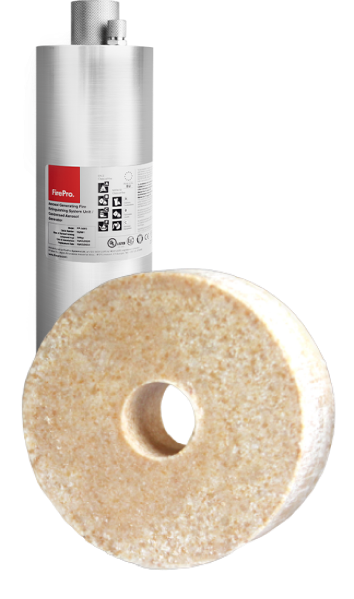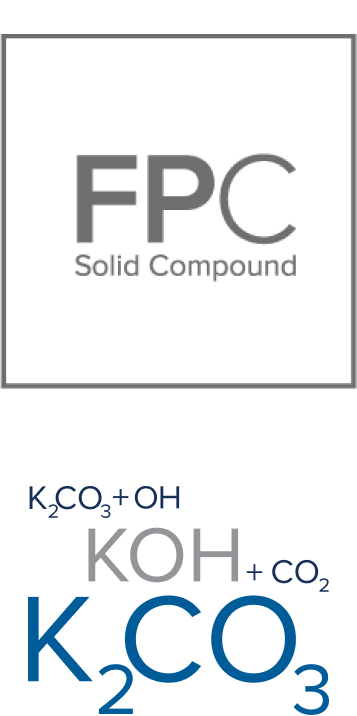
FirePro systems use the latest generation of our patented FPC solid compound that is the culmination of many years of research and development. When activated the FPC solid compound is transformed into a rapidly expanding, extremely effective and efficient fire suppressing condensed aerosol.
The aerosol is propagated and evenly distributed in the enclosure under protection using the momentum generated during the transformation process. Unlike gaseous agents, the total flooding effect is achieved without increasing the pressure in the protected area. Fire suppression is accomplished by the interruption of the chemical chain reactions occurring in the fire and not by the depletion of oxygen or cooling as associated with traditional (gaseous) agents.

FirePro technology suppresses fire by inhibiting the chemical chain reactions on a molecular level, without significantly depleting oxygen.
Alternative fire suppression agents suppress fire by one or a combination of the following three methods:

By absorbing heat from the fire and lowering its temperature.

By reducing or cutting-off the fuel supply.

By removing oxygen or reducing it below a certain level.

In a typical fire, there is an intensive reaction between atoms and unstable free radicals in the presence of oxygen. This process continues until the burning fuel is depleted. FirePro suppresses fire predominantly by inhibiting, on a molecular level, the chemical chain reactions of combustion.
On activation of the FirePro condensed aerosol generator, the FPC compound is transformed into a rapidly expanding fire suppression condensed aerosol consisting mainly of Potassium Carbonate K2 CO3 (active agent), N2 (inert gas), H2O (vapor), and other carrier gasses in minor quantities. The gas-type, 3-D properties of the condensed aerosol, facilitate its even and fast distribution in the protected volume, as well as its flow into the natural convection currents of combustion.
The solid particles of Potassium salts which are a few microns in size, suspended in a ratio a blend of gases forming a medium that behaves like a gas with total flooding properties. This increases efficiency – which results in less quantities of fire suppression agent required.
When the condensed aerosol reaches and reacts with the flame, Potassium radicals (K*) are formed mainly from the disassociation of K2 CO3. The K*s bind to other flame free radicals (hydroxyls – OH-) forming stable products such as KOH. This action suppresses fire without significantly depleting the ambient oxygen content. KOH reacts further in the presence of CO2 and forms stable K2 CO3.
The solid particles of Potassium Carbonate (K2 CO3) have a diameter of less than five microns and remain in suspension in the protected area. Hold times determined by the standards are often exceeded, preventing further re-ignition of the fire.

The FirePro fire suppression condensed aerosol technology is suitable for Fire Classes A, B, C & F (according to EN2 Classification) and A, B & C (according to NFPA10 Classification).



The FPC solid compound, developed after many years of Research & Development, utilizes environmentally friendly Potassium salts. We are dedicated to quality and the environment and have ISO9001 2015 and ISO14001 certification.
Made By: Empire Design
A legjobb felhasználói élmény biztosítása érdekében olyan technológiákat használunk, mint például a cookie-k, hogy tároljuk az eszközinformációkat és/vagy hozzáférjünk azokhoz. Ezen technológiákhoz való hozzájárulás lehetővé teszi számunkra, hogy olyan adatokat dolgozzunk fel ezen az oldalon, mint a böngészési viselkedés vagy az egyedi azonosítók. A hozzájárulás elmaradása vagy visszavonása hátrányosan befolyásolhat bizonyos funkciókat és funkciókat.